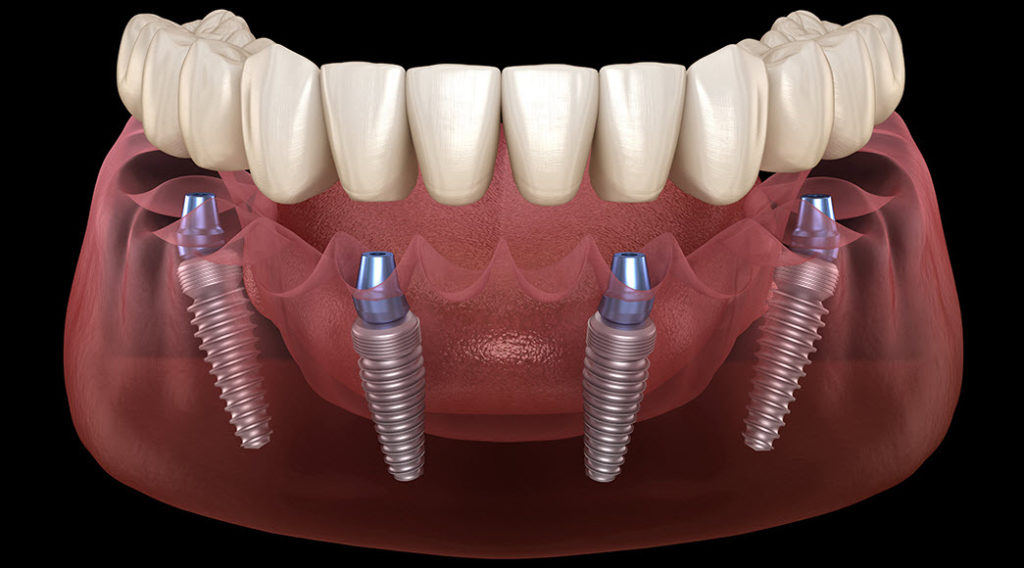Contemporary dental implantation is represented by two basic technologies – classic two-stage with a delayed prosthetic load and one-stage with the immediate placement of an orthopedic system. In the first case, the crown bridge or full denture is fixed on the implants after their full integration into the bone, in the second case the prosthetic structure is fixed on the titanium roots within 72 hours after their implantation.

Getting new teeth in 1 day is a dream for most people with adentia. Thanks to All-on-4 technology, this is now possible. The essence of the method is that only 4 implants are placed in the jaw of the patient – 2 implants vertically in the frontal area and 1 implant in the lateral areas at an angle, on which a bridge or bar prosthesis with 12 crowns is fixed.
“All-on-four: Differences from the classic technique
Adentia is divided into two types – partial and full. Partial implies the absence of a certain number of teeth, full – it is a completely toothless jaw. Until recently, with a complete loss of teeth among the options for reconstructing the tooth row, were removable prosthetics or implantation of individual implants in place of each missing tooth. The choice was between an uncomfortable and unaesthetic artificial jaw or the high cost of surgery. Things have changed with the advent of a new implant technology that can restore an entire row of teeth with 4 implants.
Features of the classic implantation
Classical implantation is a two-stage process: in the first stage the implants are implanted, in the second stage the prosthesis is placed. In between the stages there is a certain period of time necessary for the healing of the titanium roots and the jawbone. The titanium roots are implanted by a flap method – the doctor cuts the gum, removes the mucosa flap, creates a cavity in the bone, in which he screws in a root-like implant and sews up the wound.
After complete osseointegration (after 3-6 months), the gingiva is cut again, and a gum former is attached to the implant to achieve the desired aesthetic gum margin. After 10-14 days, the shaper is replaced by an abutment, on which a permanent prosthetic structure is mounted. In case of bone atrophy, it is necessary to perform directed osteoplasty (on the lower jaw) or sinus elevator (on the upper jaw) before inserting the titanium root.
Peculiarities of All-on-4 implantation
The all-on-4 protocol is a one-step method used for edentulous jaws without any bone augmentation. To reconstruct the entire (single-jaw) row of teeth, four titanium roots are implanted – two vertically in the frontal area and one in the distal parts (5th, 6th tooth) at an angle of up to 45°, bypassing the important structures of the jaw (maxillary sinuses, facial nerve, etc.). Both two-component and one-component root models with flexible abutments can be used. The prosthesis is securely anchored on the abutment (with an angle of 17° to 60°).
The angled position of the lateral implants increases their contact area with the bone. This makes it possible to avoid bone grafting surgery for bone resorption or atrophy, and minimizes treatment time. On the day of surgery, a lightweight adaptive (temporary) prosthesis is attached to the titanium supports. In a year, the temporary prosthetic structure is replaced by a permanent one made of strong and durable materials (metal-ceramic, zirconium, etc.). During this time, the implants are firmly integrated into the bone and can withstand full chewing pressure.
Indications for All-on-4
- Complete adentia of the 1st or 2nd jaw;
- Partially present teeth, but their condition requires extraction;
- Periodontitis, periodontal disease, accompanied by overdentition, loss of teeth, gingival recession, exposure of roots;
- bone deficiency;
- intolerance to removable prosthetic constructions;
- replacement of removable system with prosthesis on implants.
Indications for classical implantation
- Single, incisional, endodontic defects;
- Partial, total adentia;
- Pathological wear of teeth;
- Open bite.
